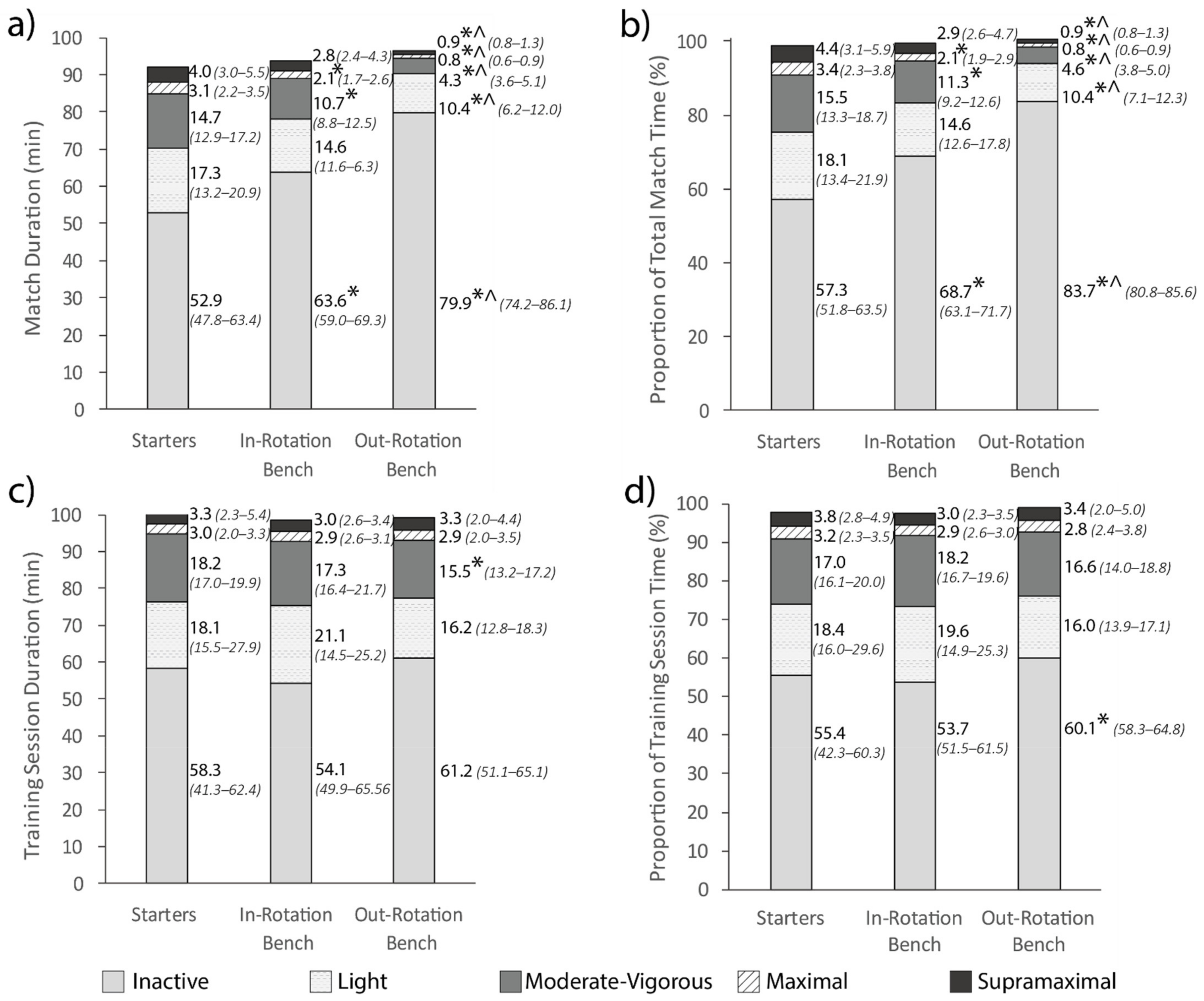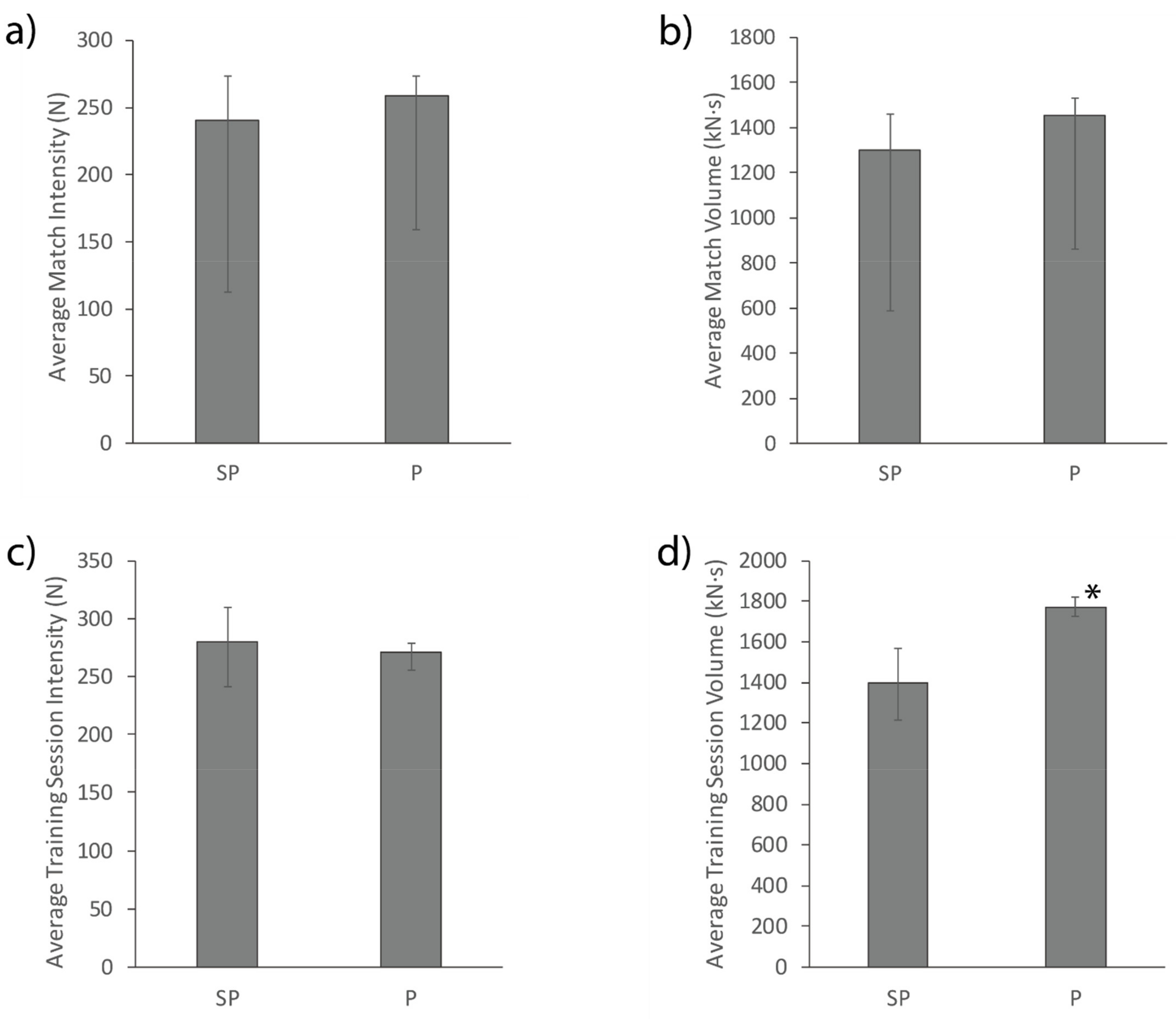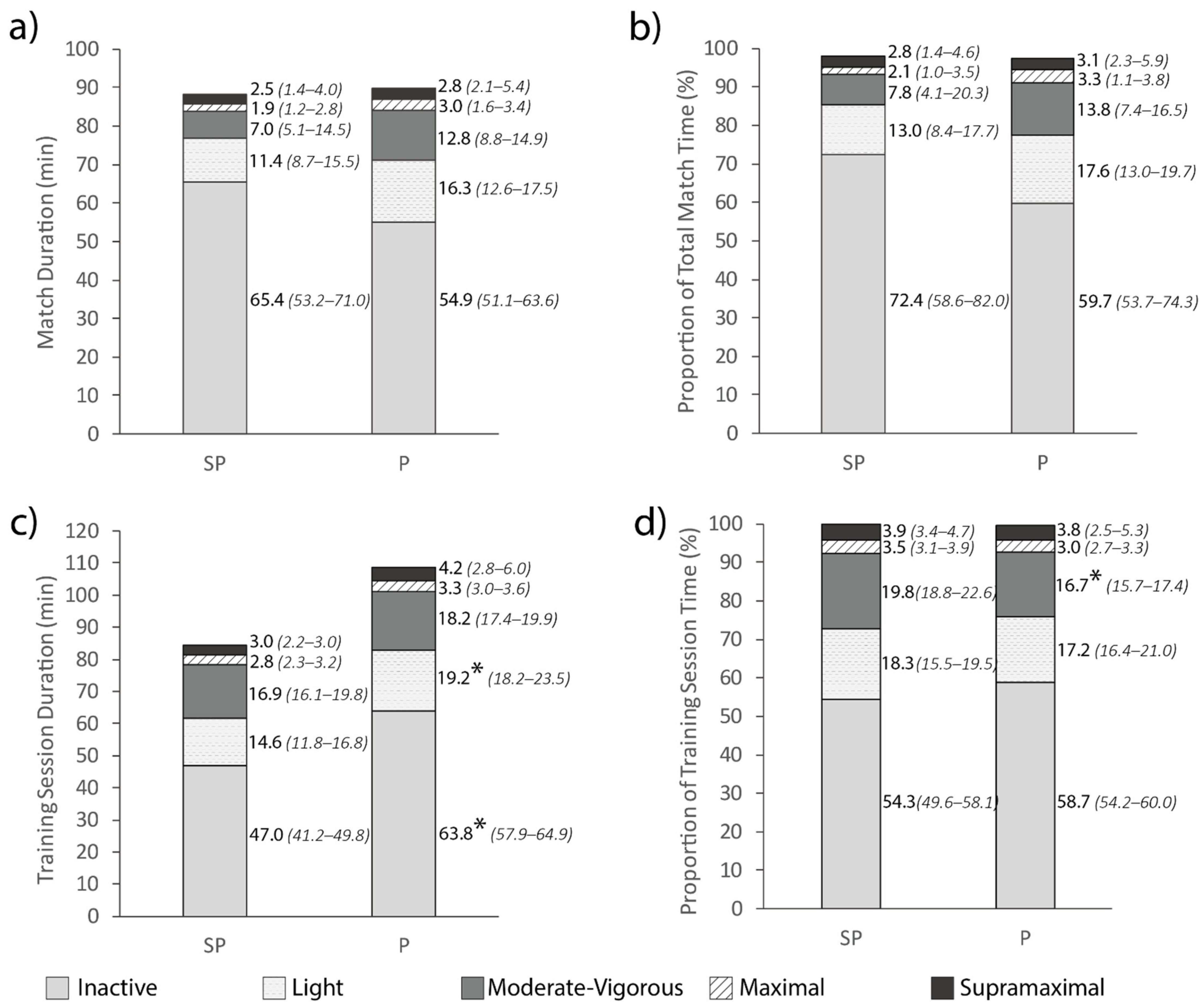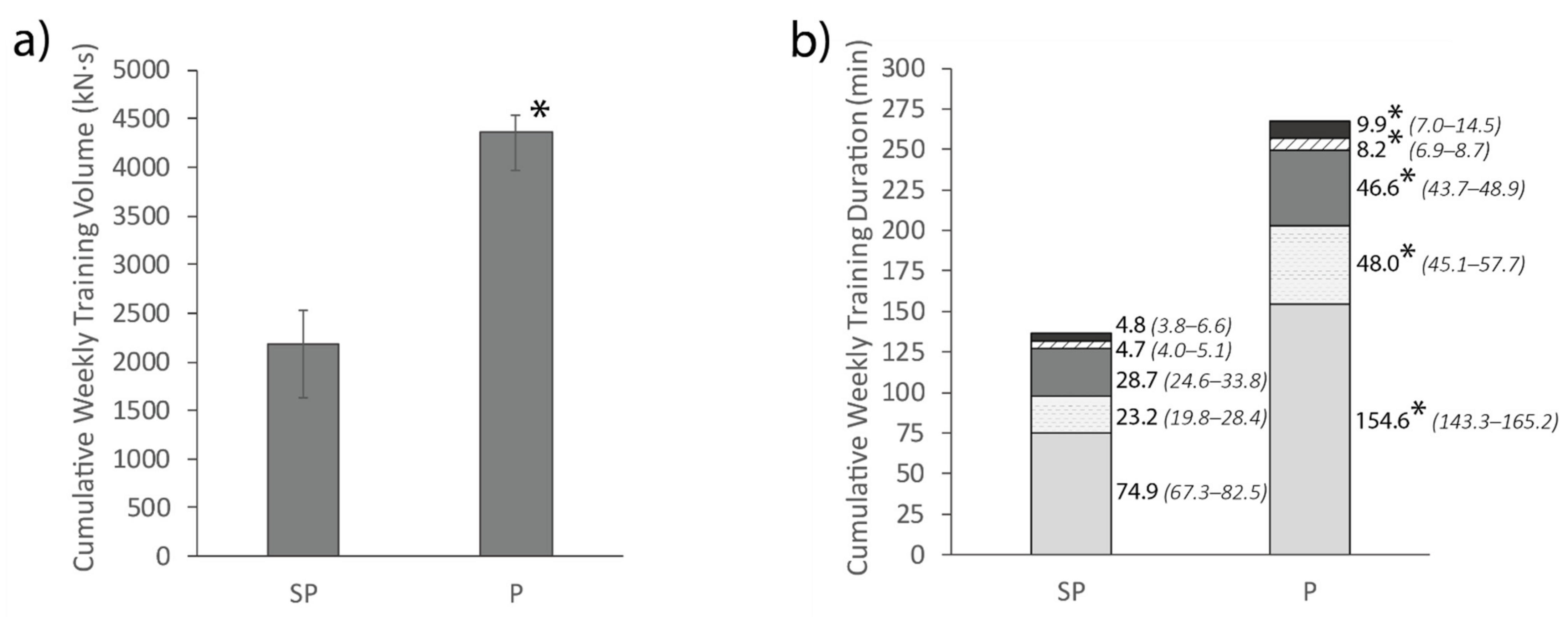Effect of Player Role and Competition Level on Player Demands in Basketball
Abstract
1. Introduction
2. Materials and Methods
2.1. Participants
2.2. Procedures
2.3. Data Analysis
2.4. Statistical Analyses
3. Results
3.1. Part A
3.2. Part B
4. Discussion
5. Conclusions
Author Contributions
Funding
Institutional Review Board Statement
Informed Consent Statement
Data Availability Statement
Acknowledgments
Conflicts of Interest
References
- Ziv, G.; Lidor, R. Physical Attributes, Physiological Characteristics, On-Court Performances and Nutritional Strategies of Female and Male Basketball Players. Sports Med. 2009, 39, 547–568. [Google Scholar] [CrossRef] [PubMed]
- Gabbett, T.J.; Hulin, B.T.; Blanch, P.; Whiteley, R. High training workloads alone do not cause sports injuries: How you get there is the real issue. Br. J. Sports Med. 2016, 50, 444–445. [Google Scholar] [CrossRef]
- Foster, C.; Boullosa, D.; McGuigan, M.; Fusco, A.; Cortis, C.; Arney, B.E.; Orton, B.; Dodge, C.; Jaime, S.; Radtke, K.; et al. 25 Years of Session Rating of Perceived Exertion: Historical Perspective and Development. Int. J. Sports Physiol. Perform. 2020, 1–10. [Google Scholar] [CrossRef]
- Stojanović, E.; Stojiljković, N.; Scanlan, A.T.; Dalbo, V.J.; Berkelmans, D.M.; Milanović, Z. The Activity Demands and Physiological Responses Encountered During Basketball Match-Play: A Systematic Review. Sports Med. 2018, 48, 111–135. [Google Scholar] [CrossRef] [PubMed]
- Staunton, C.; Wundersitz, D.; Gordon, B.; Kingsley, M. Accelerometry-Derived Relative Exercise Intensities in Elite Women’s Basketball. Int. J. Sports Med. 2018, 39, 822–827. [Google Scholar] [CrossRef]
- Gonzalez, A.M.; Hoffman, J.R.; Rogowski, J.P.; Burgos, W.; Manalo, E.; Weise, K.; Fragala, M.S.; Stout, J.R. Performance Changes in NBA Basketball Players Vary in Starters vs. Nonstarters Over a Competitive Season. J. Strength Cond. Res. 2013, 27, 611–615. [Google Scholar] [CrossRef]
- Gonzalez, A.M.; Hoffman, J.R.; Scallin-Perez, J.R.; Stout, J.R.; Fragala, M.S. Performance Changes in National Collegiate Athletic Association Division I Women Basketball Players During a Competitive Season. J. Strength Cond. Res. 2012, 26, 3197–3203. [Google Scholar] [CrossRef] [PubMed]
- Kubatko, J.; Oliver, D.; Pelton, K.; Rosenbaum, D.T. A Starting Point for Analyzing Basketball Statistics. J. Quant. Anal. Sports 2007, 3. [Google Scholar] [CrossRef]
- Clay, C.D.; Clay, E.K. Player Rotation, On-court Performance and Game Outcomes in NCAA Men’s Basketball. Int. J. Perform. Anal. Sport 2014, 14, 606–619. [Google Scholar] [CrossRef]
- Lewindon, D.; Joyce, D. (Eds.) High-Performance Training for Sports; Human Kinetics: Champaign, IL, USA, 2014. [Google Scholar]
- Ferioli, D.; Schelling, X.; Bosio, A.; La Torre, A.; Rucco, D.; Rampinini, E. Match Activities in Basketball Games: Comparison Between Different Competitive Levels. J. Strength Cond. Res. 2020, 34, 172–182. [Google Scholar] [CrossRef] [PubMed]
- Scanlan, A.; Dascombe, B.; Reaburn, P. A comparison of the activity demands of elite and sub-elite Australian men’s basketball competition. J. Sports Sci. 2011, 29, 1153–1160. [Google Scholar] [CrossRef]
- Theberge, N.; Birrell, S. Structural constraints facing women in sport. In Women and Sport: Interdisciplinary Perspectives; Human Kinetics: Champaign, IL, USA, 1994; p. 331. [Google Scholar]
- Scanlan, A.T.; Dascombe, B.J.; Kidcaff, A.P.; Peucker, J.L.; Dalbo, V.J. Gender-Specific Activity Demands Experienced During Semiprofessional Basketball Game Play. Int. J. Sports Physiol. Perform. 2015, 10, 618–625. [Google Scholar] [CrossRef] [PubMed]
- Osgnach, C.; Poser, S.; Bernardini, R.; Rinaldo, R.; DI Prampero, P.E. Energy Cost and Metabolic Power in Elite Soccer. Med. Sci. Sports Exerc. 2010, 42, 170–178. [Google Scholar] [CrossRef]
- Barrett, S.; Midgley, A.; Lovell, R. PlayerLoad™: Reliability, Convergent Validity, and Influence of Unit Position during Treadmill Running. Int. J. Sports Physiol. Perform. 2014, 9, 945–952. [Google Scholar] [CrossRef] [PubMed]
- Staunton, C.; Wundersitz, D.; Gordon, B.; Kingsley, M. Construct Validity of Accelerometry-Derived Force to Quantify Basketball Movement Patterns. Int. J. Sports Med. 2017, 38, 1090–1096. [Google Scholar] [CrossRef]
- Wundersitz, D.W.; Josman, C.; Gupta, R.; Netto, K.J.; Gastin, P.B.; Robertson, S. Classification of team sport activities using a single wearable tracking device. J. Biomech. 2015, 48, 3975–3981. [Google Scholar] [CrossRef] [PubMed]
- Boyd, L.J.; Ball, K.; Aughey, R.J. The Reliability of MinimaxX Accelerometers for Measuring Physical Activity in Australian Football. Int. J. Sports Physiol. Perform. 2011, 6, 311–321. [Google Scholar] [CrossRef] [PubMed]
- Esliger, D.W.; Tremblay, M.S. Technical Reliability Assessment of Three Accelerometer Models in a Mechanical Setup. Med. Sci. Sports Exerc. 2006, 38, 2173–2181. [Google Scholar] [CrossRef]
- Kelly, S.J.; Murphy, A.J.; Watsford, M.L.; Austin, D.; Rennie, M. Reliability and Validity of Sports Accelerometers During Static and Dynamic Testing. Int. J. Sports Physiol. Perform. 2015, 10, 106–111. [Google Scholar] [CrossRef]
- Nicolella, D.P.; Torres-Ronda, L.; Saylor, K.J.; Schelling, X. Validity and reliability of an accelerometer-based player tracking device. PLOS ONE 2018, 13, e0191823. [Google Scholar] [CrossRef]
- Dwyer, G.B.; Davis, S.E. ACSM’s Health-Related Physical Fitness Assessment Manual, 2nd ed.; Lippincott Williams & Wilkins: Baltimore, MD, USA, 2008. [Google Scholar]
- Whaley, M.H.; Brubaker, P.H.; Otto, R.M.; Armstrong, L.E. ACSM’s Guidelines for Exercise Testing and Prescription, 7th ed.; Lippincott Williams & Wilkins: Baltimore, MD, USA, 2006. [Google Scholar]
- Garber, C.E.; Blissmer, B.; Deschenes, M.R.; Franklin, B.A.; Lamonte, M.J.; Lee, I.M.; Nieman, D.C.; Swain, D.P. American College of Sports Medicine position stand. Quantity and quality of exercise for developing and maintaining cardiorespiratory, musculoskeletal, and neuromotor fitness in apparently healthy adults: Guidance for prescribing exercise. Med. Sci. Sports Exerc. 2011, 43, 1334–1359. [Google Scholar] [CrossRef]
- Basketball Australia. Match details. Available online: http://wnbl.basketball/stats (accessed on 18 June 2019).
- Genius Sports Group. Available online: fibalivestats.com (accessed on 18 June 2019).
- Hopkins, W. A Scale of Magnitudes for Effect Statistics. Available online: http://sportsci.org/resource/stats/effectmag.html (accessed on 28 July 2019).
- Waldron, M.; Highton, J. Fatigue and Pacing in High-Intensity Intermittent Team Sport: An Update. Sports Med. 2014, 44, 1645–1658. [Google Scholar] [CrossRef]
- Conte, D.; Kolb, N.; Scanlan, A.T.; Santolamazza, F. Monitoring Training Load and Well-Being During the In-Season Phase in National Collegiate Athletic Association Division I Men’s Basketball. Int. J. Sports Physiol. Perform. 2018, 13, 1067–1074. [Google Scholar] [CrossRef] [PubMed]
- Ibáñez, S.J.; Feu, S.; García, J.; Parejo, I.; Cañadas, M. Shot differences between professional (ACB) and amateur (EBA) basketball teams. Multifactorial study. Rev. Psicol. Deporte 2009, 18, 313–317. [Google Scholar]
- Sampaio, J.; Godoy, S.I.; Feu, S. Discriminative Power of Basketball Game-Related Statistics by Level of Competition and Sex. Percept. Mot. Ski. 2004, 99, 1231–1238. [Google Scholar] [CrossRef]
- Mujika, I.; Halson, S.; Burke, L.M.; Balagué, G.; Farrow, D. An Integrated, Multifactorial Approach to Periodization for Optimal Performance in Individual and Team Sports. Int. J. Sports Physiol. Perform. 2018, 13, 538–561. [Google Scholar] [CrossRef] [PubMed]
- Fox, J.L.; Conte, D.; Stanton, R.; McLean, B.; Scanlan, A.T. The application of accelerometer-derived moving averages to quantify peak demands in basketball: A comparison of sample duration, playing role, and session type. J. Strength Cond. Res. 2020. [Google Scholar] [CrossRef]





| Team | Players | Age (Years) | Height (cm) | Mass (kg) | Training Sessions Monitored | Matches Monitored |
|---|---|---|---|---|---|---|
| SP Men | 13 | 26.8 ± 5.2 | 192.3 ± 7.5 | 96.2 ± 16.4 | 32 | 22 |
| SP Women | 12 | 28.1 ± 5.0 | 176.0 ± 9.7 | 75.9 ± 18.2 | 33 | 21 |
| P Women | 12 | 25.2 ± 5.9 | 180.6 ± 10.7 | 79.3 ± 17.1 | 54 | 20 |
| Intensity Band | (%) | Associated AvFNET Thresholds (N; Mean ± SD) |
|---|---|---|
| Inactive | ≤10% | ≤216 ± 55 |
| Light | >10–40% | >216 ± 55–454 ± 92 |
| Moderate-Vigorous | >40–90% | >454 ± 92–850 ± 174 |
| Maximal | >90–100% | >850 ± 174–929 ± 191 |
| Supramaximal | >100% | >929 ± 191 |
Publisher’s Note: MDPI stays neutral with regard to jurisdictional claims in published maps and institutional affiliations. |
© 2021 by the authors. Licensee MDPI, Basel, Switzerland. This article is an open access article distributed under the terms and conditions of the Creative Commons Attribution (CC BY) license (http://creativecommons.org/licenses/by/4.0/).
Share and Cite
Palmer, J.; Wundersitz, D.; Bini, R.; Kingsley, M. Effect of Player Role and Competition Level on Player Demands in Basketball. Sports 2021, 9, 38. https://doi.org/10.3390/sports9030038
Palmer J, Wundersitz D, Bini R, Kingsley M. Effect of Player Role and Competition Level on Player Demands in Basketball. Sports. 2021; 9(3):38. https://doi.org/10.3390/sports9030038
Chicago/Turabian StylePalmer, Jodie, Daniel Wundersitz, Rodrigo Bini, and Michael Kingsley. 2021. "Effect of Player Role and Competition Level on Player Demands in Basketball" Sports 9, no. 3: 38. https://doi.org/10.3390/sports9030038
APA StylePalmer, J., Wundersitz, D., Bini, R., & Kingsley, M. (2021). Effect of Player Role and Competition Level on Player Demands in Basketball. Sports, 9(3), 38. https://doi.org/10.3390/sports9030038








